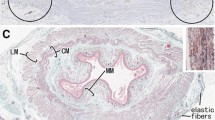Summary
The non-neuronal, supportive cells of the enteric nerve plexus were investigated in the colon and rectum of adult and developing rats by means of immunohistochemistry, utilizing antisera against GFA protein and S-100 protein. Immunoreactivity to GFA protein was almost exclusively found in cells associated with the myenteric plexus and a small number of cells within the submucous ganglia. On the other hand, the use of S-100 protein antiserum resulted in the visualization of all supportive elements in the enteric nervous system. However, two types of supportive cells could be tentatively differentiated in the enteric nerve plexus during the second week of postnatal development, using GFA protein and S-100 protein antisera; GFA protein-positive cells were clearly discernible from S-100 protein-positive cells in terms of both the morphological profiles and immunohistochemical properties. It was assumed that at least two different types of supportive cells are contained in the enteric nerve plexus. We suggest that in the enteric nervous system the terms “glial cells” and “Schwann cells” should be employed to designate the supportive cells containing GFA and S-100 proteins, and cells containing S-100 protein, respectively. We discuss the possibility that glial cells are associated with the parasympathetic preganglionic fibres directly derived from the central nervous system, while Schwann cells originate from the neural crest.
Similar content being viewed by others
References
Bignami A, Eng LF, Dahl D, Uyeda CT (1972) Localization of the glial fibrillary acidic protein in astrocytes by immunofluorescence. Brain Res 43:429–435
Brizzee KR (1949) Histogenesis of the supporting tissue in the spinal and the sympathetic trunk ganglia in the chick. J Comp Neurol 91:129–146
Cook RD, Burnstock G (1976) The ultrastructure of Auerbach's plexus in the guinea-pig. II. Non-neuronal elements. J Neurocytol 5:195–206
Costa M, Buffa R, Furness JB, Solcia E (1980) Immunohistochemical localization of polypeptides in peripheral autonomic nerves using whole mount preparations. Histochemistry 65:157–165
Dahl D, Bignami A (1976) Immunogenic properties of the glial fibrillary acidic protein. Brain Res 116:150–157
Dahl D, Chi NH, Miles LE, Nguyen BT, Bignami A (1982) Glial fibrillary acidic (GFA) protein in Schwann cells: Fact or artifact?. J Histochem Cytochem 30:912–918
Eng LF (1985) Glial fibrillary acidic protein (GFAP): The major protein of glial intermediate filaments in differentiated astrocytes. J Neuroimmunol 8:203–214
Eng LF, Vanderhaeghen JJ, Bignami A, Gerstl B (1971) An acidic protein isolated from fibrous astrocytes. Brain Res 28:351–354
Ferri G-L, Probert L, Cocchia D, Michetti F, Marangos PJ, Polak JM (1982) Evidence for the presence of S-100 protein in the glial component of the human enteric nervous system. Nature 297:409–410
Gabella G (1972) Fine structure of the myenteric plexus in the guinea-pig ileum. J Anat 111:69–97
Gabella G (1979) Innervation of the gastrointestinal tract. Int Rev Cytol 59:129–193
Gard AL, White FP, Dutton GR (1985) Extra-neural glial fibrillary acidic protein (GFAP) immunoreactivity in perisinusoidal stellate cells of rat liver. J Neuroimmunol 8:359–375
Hacker GW, Polak JM, Springall DR, Ballesta J, Cadieux A, Gu J, Trojanowski JQ (1985) Antibodies to neurofilament protein and other brain proteins reveal the innervation of peripheral organs. Histochemistry 82:581–593
Hammond WS (1949) Formation of the sympathetic nervous system in the trunk of the chick embryo following removal of the thoracic neural tube. J Comp Neurol 91:67–85
Hatfield JS, Skoff RP, Maisel H, Eng LF (1984) Glial fibrillary acidic protein is localized in the lens epithelium. J Cell Biol 98:1895–1898
Jessen KR, Mirsky R (1980) Glial cells in the enteric nervous system contain glial fibrillary acidic protein. Nature 286:736–737
Jessen KR, Mirsky R (1985) Glial fibrillary acidic polypeptides in peripheral glia: Molecular weight, heterogeneity and distribution. J Neuroimmunol 8:377–393
Jessen KR, Thorpe R, Mirsky R (1984) Molecular identity, distribution and heterogeneity of glial fibrillary acidic protein: An immunoblotting and immunohistochemical study of Schwann cells, satellite cells, enteric glia and astrocytes. J Neurocytol 13:187–200
Kobayashi S, Suzuki M, Endo T, Tsuji S, Daniel EE (1986) Framework of the enteric nerve plexuses: An immunocytochemical study in the guinea pig jejunum using an antiserum to S-100 protein. Arch Histol Jpn 49:159–188
Komuro T, Baluk P, Burnstock G (1982) An ultrastructural study of neurons and non-neuronal cells in the myenteric plexus of the rabbit colon. Neuroscience 7:1797–1806
Le Douarin NM (1980) The ontogeny of the neural crest in avian embryo chimaeras. Nature 286:663–669
Ludwin SK, Kosek JC, Eng LF (1976) The topographical distribution of S-100 and GFA proteins in the adult rat brain: An immunohistochemical study using horseradish peroxidase-labelled antibodies. J Comp Neurol 165:197–208
Mannoji H, Takeshita I, Fukui M, Ohta M, Kitamura K (1981) Glial fibrillary acidic protein in medulloblastoma. Acta Neuropathol 55:63–69
Matus A, Mughal S (1975) Immunohistochemical localization of S-100 protein in brain. Nature 258:746–748
Moore BW (1965) A soluble protein characteristic of the nervous system. Biochem Biophys Res Comm 19:739–744
Shanthaveerappa TR, Bourne GH (1962) The ‘perineural epithelium’, a metabolically active, continuous, protoplasmic cell barrier surrounding peripheral nerve fasciculi. J Anat 96:527–537
Stefansson K, Wollmann RL, Moore BW (1982) Distribution of S-100 protein outside the central nervous system. Brain Res 234:309–317
Weston JA (1963) A radioautographic analysis of the migration and localization of trunk neural crest cells in the chick. Dev Biol 6:279–310
Yen S-H, Fields KL (1981) Antibodies of neurofilament, glial filament, and fibroblast intermediate filament proteins bind to different cell types of the nervous system. J Cell Biol 88:115–126
Yen S-H, Fields KL (1985) A protein related to glial filaments in Schwann cells. Ann NY Acad Sci 455:538–551
Yntema CL, Hammond WS (1954) The origin of intrinsic ganglia of trunk viscera from vagal neural crest in the chick embryo. J Comp Neurol 101:515–541
Author information
Authors and Affiliations
Rights and permissions
About this article
Cite this article
Nada, O., Kawana, T. Immunohistochemical identification of supportive cell types in the enteric nervous system of the rat colon and rectum. Cell Tissue Res. 251, 523–529 (1988). https://doi.org/10.1007/BF00213999
Accepted:
Issue Date:
DOI: https://doi.org/10.1007/BF00213999




